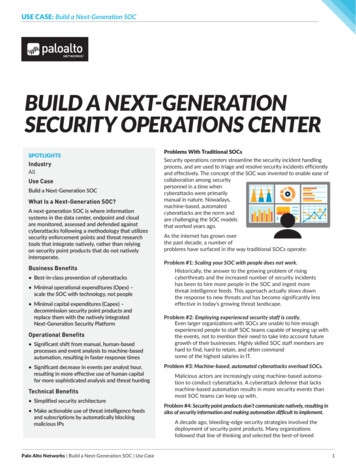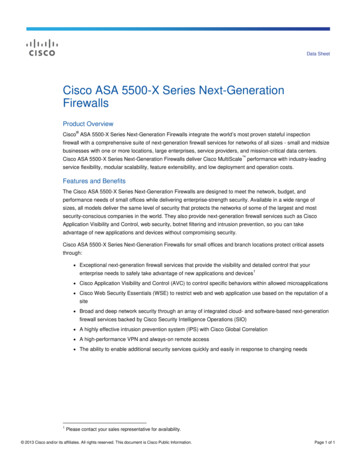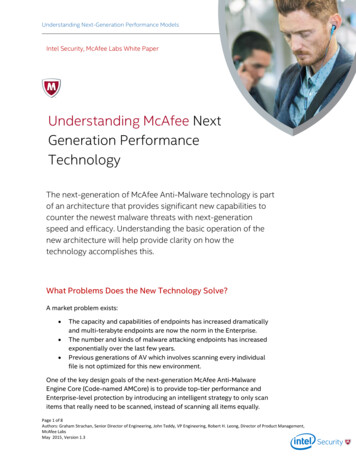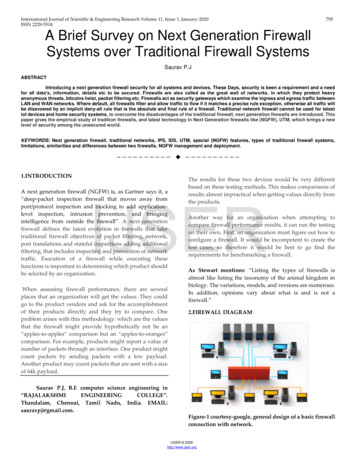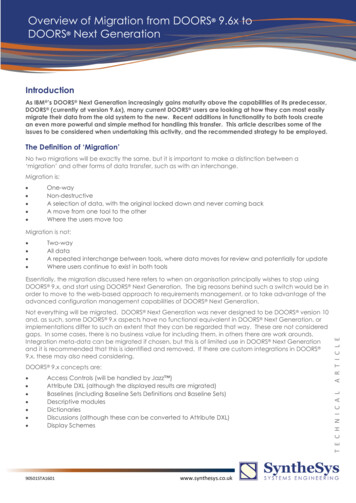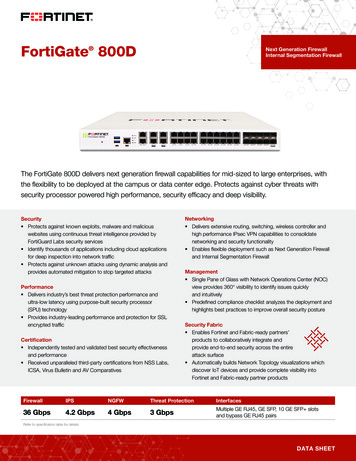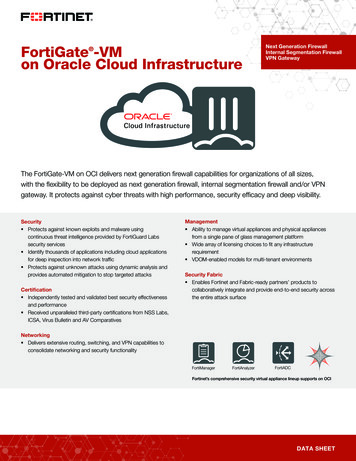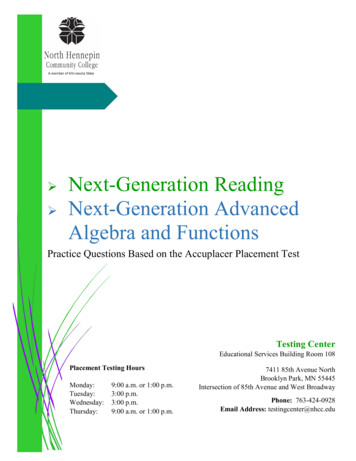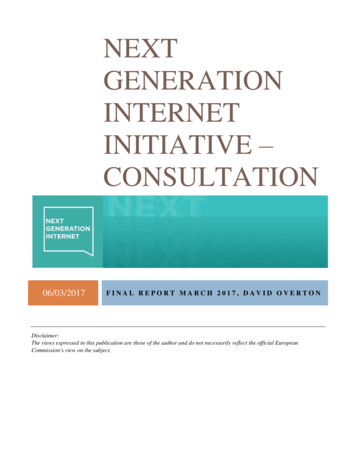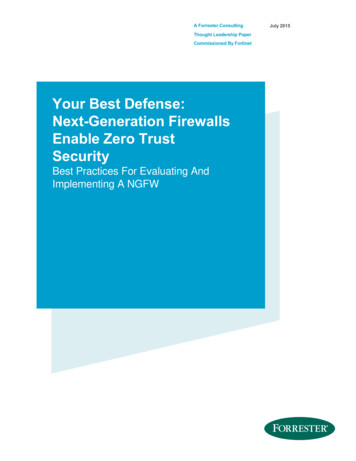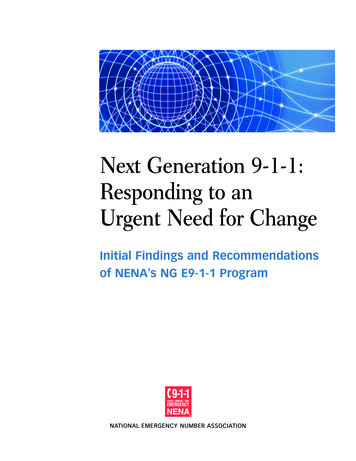
Transcription
Next Generation 9-1-1:Responding to anUrgent Need for ChangeInitial Findings and Recommendationsof NENA's NG E9-1-1 ProgramNATIONAL EMERGENCY NUMBER ASSOCIATION
Next Generation 9-1-1:Responding to an Urgent Need for ChangeInitial Findings and Recommendations of NENA’s NG E9-1-1 ProgramNG E9-1-1 PROGRAM PARTNERSNENA wishes to acknowledge the valuable contributions ofits program partners to the NG E9-1-1 Program. In additionto financial support, the partners provided much of thesubstantive content to this first-year effort.Inside1 NG E9-1-1 ProgramExecutive SummaryAmerica OnlineNeuStarAmerican Association of PoisonControl CentersOnStarAT&TRosumCingularSprint Nexteland RecommendationsCOMCARETCI Emerging National PolicyIssues (page 8)HBF Group, Inc.TeleCommunication SystemsIntradoT-Mobile Requirements/Standards(page 14)L. Robert Kimball & AssociatesTexas 9-1-1 AllianceLevel 3 Communications Data (page 15)MapInfoTexas Commission on StateEmergency Communications Location/National CallRouting (page 15)MCITruePositionMotorolaVerizon Emergency CommunicationsCoordination andInteroperability (page 16)National Academies ofEmergency DispatchVonage3 What Is NG 9-1-1? The Futureof EmergencyCommunications7 2005 Topic Area Findings Disaster Planning andRecovery (page 17) Education/EducationalOpportunities (page 19)10 The Future of 9-1-1 andEmergency Communications:A Blueprint for a "System ofSystems"20 2006 Program PlanPositron Public Safety SystemsFOR MORE INFORMATIONTo learn more about the topic area meetings, or for information on how tobecome a partner of the Next Generation E9-1-1 Program, contact Dr. RobertCobb, Program Manager, at 1-800-332-3911 or via e-mail at bcobb@nena.org.PUBLICATION DATE: FEBRUARY 2006C NATIONAL EMERGENCY NUMBER ASSOCIATION4350 NORTH FAIRFAX DRIVE, SUITE 750ARLINGTON, VA 222031-800-332-3911Visit www.nena.org for a copy of this report and for additionalinformation on the NG E9-1-1 program.
2 0 0 5 N E X T G E N E R AT I O N E 9 - 1 - 1 P R O G R A MNG E9-1-1 EXECUTIVE SUMMARYExecutive SummaryIn the past 15 years, advancements in modern communications technologyhave created the need for a more advanced system to access emergency care.While the existing 9-1-1 system has been a success story for more than 30years, it has been stretched to its limit as technology advances. New wireless andNote: The terms “NG 9-1-1” and“NG E9-1-1” used in this report arenot interchangeable. The formerrefers to next generation systemsgenerically while the latter refersto NENA’s program.IP-based communications devices are being developed at a rapid rate, offeringcapabilities such as video and text messaging.Unfortunately, the current 9-1-1 system was never intended to receive calls anddata from these new and emerging technologies. As a result, it is being asked toperform functions it was not designed to handle. In short, the nation’s 9-1-1 sys-Program Visiontems are in need of a significant overhaul.An ‘NG 9-1-1 system’ thatAccording to a recent research and market survey1, more than 9 percent of U.S.wireless subscribers currently use wireless handsets as their primary phone, andis accessible anytime,anywhere, from any device.between 23 and 37 percent of U.S. wireless subscribers will use their handsets astheir primary phone by 2009. Research also suggests that the 3 million U.S. residential VoIP subscribers who exist today will exceed 27 million by 20092.In addition to the proliferation of new devices and data sources, local and wide areawireless networks are allowing the mobile public to communicate wirelessly frommore locations. Some cities, including San Francisco and Philadelphia, are in theProgram MissionTo establish a voluntary,open, unified approach toenabling ‘NG 9-1-1’ systemsand services.process of provisioning city-wide WiMax networks that will potentially allow the public to wirelessly communicate on IP-enabled devices from anywhere in their metropolitan areas.Applying new technologies to emergency communications offers significantopportunities but also presents major challenges to the 9-1-1 community andraises questions that have yet to be answered.How do you locate a business traveler dialing 9-1-1 from a portable computer on the10th floor of a hotel in an unfamiliar city? How do you route the IP-based 9-1-1 calland its associated data to the appropriate Public Safety Answering Point (PSAP)?How can this data be seamlessly shared among all entities involved with emergencyresponse? How will the 9-1-1 system maintain funding levels as more people rely onwireless or IP voice communication? And, if we are to migrate from today’s 9-1-1system to IP-based emergency communications networks, how will such a migrationbe funded and what jurisdictional, regulatory and legislative issues might arise?1.In-Stat Research and Markets Survey, Report Number: IN0502092MCM, October 2005.2.IDC: http://www.idc.com.1
NG E9-1-1 EXECUTIVE SUMMARY2 0 0 5 N E X T G E N E R AT I O N E 9 - 1 - 1 P R O G R A MTo respond to the changing communications landscape, it is apparent that there is acritical need for an IP-enabled Next Generation 9-1-1 (NG 9-1- 1) system, one thatis able to adapt rapidly to new technology and support new communications devices.Such a move, from today’s 9-1-1 system to NG 9-1-1, requires a national focus onkey technical, operational, and policy issues. The National Emergency NumberAssociation (NENA) formed the NG E9-1-1 Program to create a public-private partnership to improve the nation’s 9-1-1 system. The primary objective of this programis to establish a cohesive vision that brings leading technology providers and publicsafety stakeholders together in order to focus on all aspects of NG 9-1-1.Since migrating to NG 9-1-1 requires significant collaboration among multipleparties, a major focus of the NG E9-1-1 Program has been to ensure that allissues are thoroughly examined with a national project management approach.“ [the] 3 million U.S. residentialVoIP subscribers who exist todaywill exceed 27 million by 2009.“By the end of 2004, 16 organizations had committed resources and representationto the NG E9-1-1 program. By the end of 2005 the program grew to include 26partners, representing wireline providers, wireless carriers, VoIP service providers,associations, non-profit organizations, and 9-1-1 product and service vendors.“Applying new technologies toemergency communicationsoffers significant opportunitiesbut also presents majorchallenges to the 9-1-1 communityand raises questions that haveyet to be answered.“Program Structure and ResultsThe original structure of NG E9-1-1 consisted of a management team and threeworking group roundtables. The management team included program partnersenior executives along with NENA leadership and staff to provide strategic oversight for the program. The individual roundtables were formed to identify andaddress technical, operational and policy issues. In cases where an issue hadimplications for multiple roundtables, the different groups met together to ensurethat issues were broadly considered.Program partners identified and addressed a multitude of overlapping issues,including funding, jurisdictional perspectives, standards, education, trials, datasharing and many other topics. When possible, the partners provided specificrecommendations. In other instances, issues have been identified that requireadditional consideration. Recommendations of the program partners are sharedwith existing NENA committees as valued input. In many instances, such inputhas resulted in positive action.Much work remains to be done. NENA will continue its leadership position in thedevelopment and enabling of an NG 9-1-1 system. The 2006 NENA NG E9-1-1Program is designed to further address the issues identified in 2005.2
2 0 0 5 N E X T G E N E R AT I O N E 9 - 1 - 1 P R O G R A MWHAT IS NG 9-1-1?What is NG 9-1-1?The Future of EmergencyCommunicationsWhile the events of Sept. 11, 2001, brought national attention to the nation’s outmoded emergency communications systems, NENA had already recognized thelimits of the current systems, resulting in publication of a 9-1-1 Future Path Planin early 2001. By 2003, NENA had initiated IP-based 9-1-1 developments as otherorganizations also embarked on emergency communications initiatives3.Hurricanes in 2004 and 2005 further illustrated the critical role that communications plays in supporting emergency response efforts of the public, first respondersand government. These natural disasters placed additional emphasis on disasterpreparedness, response and recovery, and the need for flexible technology.Currently, emergency responders are being asked to save lives with communicationsand information technology that most businesses and individuals have moved farbeyond. In some instances, emergency responders are being sent into harm’s waywithout the information they need. Some emergency responders are even beingasked to operate without technology that was considered modern 20 years ago.3.Notable among these, and from which the source summary paper borrows liberally, are the FCC’s NRIC advisory group, especiallyFocus Groups 1B, 1D, 2A and 2B reports, the NENA NG 9-1-1 (i3) requirements and design, federal DOJ and DHS work on XMLbased data standardization, the USDOT NG 9-1-1 Coordination Initiative, and the COMCARE E-Safety Network project. Standardsefforts among many interest groups continue to develop around the opportunity to apply IP technology to radically improve and expandemergency communications capabilities.3
2 0 0 5 N E X T G E N E R AT I O N E 9 - 1 - 1 P R O G R A MWHAT IS NG 9-1-1?Emergency ResponderService Function(s)(Law Enforcement, Fire, EMS,Hazmat, Poison Control)IP PSAPsMediaServicesGovernmentServicesFirewallWeb SourcedDatabase ServicesRoot Discovery ServicesEmergency ServicesRouting ProxyPublic Web ServicesOVERALL EMERGENCY COMMUNICATIONS NEEDSEmergency ServicesIP NetworkPrivate WebServicesCallPlease refer to pagesEmergency10 and11PSAP GatewayDNSRouting Functionfor a graphic representationofSR GatewayThe Future of 9-1-1 andEmergencyCommunications:InternetEmergency CallRouting FunctionA Blueprint fora ‘System ofSystems’IP Routerrmination/nctionsLIS(s)IP Originated PublicAccess NetworksLegacyPSAP w/IPLocation Validation/Routing rconnection(becomes IP)SIP/H.323ClientsTelematics CallsWireless ClientNOTE: All call sources canaccess NG 9-1-1 at start of transitionWirelineCall SourcesWirelessCall SourcesThe National Reliability andInteroperability Council (NRIC),an advisory group of the FCC,defined an effective futureemergency communicationssystem as an “internetwork”—a set of policies, tools, interfacesand standards that connectsecurely the multiplicity of local,regional and national wirelineand wireless networks. It is, ineffect, a system of systems.4DatabaseServicesPure Legacy PSAPSelective RouterE9-1-1GatewayM ClientA critical weakness in existing emergency communications systems is that emergencyresponse agencies are generally isolated from each other. Presently, the “emergency responsecommunity” includes public and private organizations that need to share emergency information, including: law enforcement, fire services, EMS, 9-1-1, emergency operations centers,hospitals, clinics, public health agencies, transportation agencies, public works departments,utilities and others.The National Reliability and Interoperability Council (NRIC) Focus Group 1D, an advisory groupof the Federal Communications Commission (FCC), identified one solution within two complementary areas: technological and institutional. In December 2005, NRIC published a final reportthat defined an effective future emergency communications system as an “internetwork”4—a setof policies, tools, interfaces and standards that connect securely the multiplicity of local, regional,and national wireline and wireless networks. Such an internetwork will enable modern, integratedinformation capabilities to support local, regional and national emergency needs. It is, in effect, asystem of systems5.NENA’s 9-1-1 Future Path Plan also proposed a hierarchy of interconnected local, regional andnational IP networks that would enable NG 9-1-1 and many other emergency communicationsapplications. The resulting model is a set of coordinated applications on an IP internetwork thatserves multiple governmental functions and seamlessly interfaces voice and electronic data. Inaddition to improving response for daily emergencies, such a model would also improve homeland security by providing a nationally coordinated emergency response system.Routing ControlThe needs of the new system of emergency communications include: Improved natural disaster management, including the prevention of and response to potential terrorist actions. Full support of new communications and information technology for emergency services. Reduce the danger of viruses capable of generating automated 9-1-1 calls and overwhelming the network. Use and enhance increasingly available sources of information that are only readily availablewith a flexible, wide access, high bandwidth network. Improved accessibility and increased compatibility to ensure all Americans have access tothe emergency response system, including those with disabilities.Today, millions of cell phone subscribers and commercial vehicles with GPS and communications systems can provide precise locations and verbal descriptions of emergencies. In thefuture, more will be able to provide images or other data. New devices, such as a direct report ofa heart attack from a device worn on the chest, could also have a direct link with NG 9-1-1.Increased use of text messaging must also be supported, in general and to accommodate persons with disabilities.NG 9-1-1 will also address N11 numbers and other services, such as poison control centersusing 800 services for state/regional routing. For many VoIP customers, there is limited or noaccess to N11 numbers and many 800 numbers cannot be properly routed.Work is well underway within NENA, the Internet Engineering Task Force (IETF), federal XMLinitiatives for data management standardization and the Alliance for TelecommunicationsIndustry Solutions (ATIS) to provide the standards required to fully converge circuit switched(voice and text) and data networks into one NG 9-1-1 packet network, based on IP. Infrastructurerequirements include transport, standards, applications and services, policies and protocols, andassociated governance.4.We use this unfamiliar term to make two points: (a) our strong belief that the model of the Internet should be copied for emergencycommunications in the future (except for its failures until recently to focus proper attention on security), and (b) that we do not favorbuilding a new “national emergency network.” There are already many networks, and there need to be many more built at the state andlocal level. Our focus is on how to connect them (and applications that ride on them) into a seamless whole, rather than replace them.5.“System of Systems.” Emergency communications devices are associated with systems and networks that range in size from small tolarge. Whether large or small, the systems and the networks they use work with each other to pass information and communicationsback and forth seamlessly. In some cases, new networks must be deployed by agencies, localities, regions, states, tribes or federal agencies. In other cases, we need to connect tools, systems and networks that are already deployed. Our overall goal is that all systemstogether become a system of systems.
2 0 0 5 N E X T G E N E R AT I O N E 9 - 1 - 1 P R O G R A MWHAT IS NG 9-1-1?NG 9-1-1 AS A MAJOR APPLICATION OF THEEMERGENCY COMMUNICATIONS NETWORKAs with many other networks, NRIC Focus Group 1B foresees the convergence of data, voice,text and video networks, based on ubiquitous packet transports and using standard InternetProtocols. While 2010 will not mean the end of older telecommunications equipment, FocusGroup 1B advocates that the nation should have IP-based E9-1-1 capability, and begin its transition whenever and wherever possible.The future Emergency Services Network will accommodate a flexible services infrastructurewhere applications can be defined and introduced without requiring major overhauls to existingnetwork service providing elements. Capabilities will include the ability for regional and nationalinterests to monitor, impact and participate in emergency events or emergency preparedness.Emergency management centers at all levels of government will be able to monitor data in realtime, with an ability to recognize patterns at local, regional or national levels.Implementation of NG 9-1-1 standards will have far-reaching operational impacts: Handling calls from new devices, which will require new processes and procedures for calltakers. Connecting new network elements to the system will require new administration andmanagement tasks. Providing new capabilities, including the ability to transfer calls with location and allassociated data, will require new processes and procedures for call takers. Accessing additional data will require new call taker processes, procedures, and monitors. New databases will require new processes and procedures for call takers, databaseadministrators and management. Increased information will require new decision support tools that help interpret data forcall takers and dispatchers. Improved connectivity will create new relationships among PSAPs and other local, regionaland national emergency agencies, requiring new processes and procedures for call takersand management."Such changes to the systemwill position PSAPs as emergencycommunications hubs, but won’trestrict access by others to thesame data."“Emergency managementSuch changes to the system will position PSAPs as emergency communications hubs, butwon’t restrict access by others to the same data. In addition, supplemental data such as telematics or patient medical history can be accessed from other sources.TRANSITION AND IMPLEMENTATIONAfter design, standards and testing is completed, NG 9-1-1 capabilities can be implemented insub-state or state-level IP networks that are validated to have the security, authentication andmanagement characteristics necessary for dependable NG 9-1-1 service. As shown in thediagram on pages 10-11, IP-based telecommunications services (VoIP in fixed/static andnomadic; WiFi and WiMAX) will be able to connect to the Internet via IP routers and high-levelsecurity processes into an IP-based NG 9-1-1 system.As “local” emergency services IP networks supporting NG 9-1-1 applications become interconnected to each other as well as federal functions/networks such as homeland security, the overall benefit to emergency communications becomes a reality. An opportunity enabled by thiscapability is to “leapfrog” wireless and other services to full E9-1-1/NG 9-1-1 in areas where thetraditional network does not exist, at lower cost. For example, IP mesh networks can supplytransport where no phone and/or traditional 9-1-1 access exists (e.g., remote rural areas andIndian tribal lands).During this process, legacy telecommunications systems for wireline, wireless, VoIP andothers will likely transition to IP-based connectivity and into the local emergency services IP networks. The components highlighted in green at the lower right of the diagram on pages 10-11can be removed in preference to more effective NG 9-1-1 components and functions.Functions such as telematics will initially connect to the emergency services IP networks viathe Internet until the internetwork of emergency services IP networks is complete. At that time,these nationally oriented services can choose to move to connection through their local emergency services IP networks. Current complications such as trunk groups and individual selectiverouting switches will no longer be an issue. Data access will become a combination of baselineinformation arriving with the “call” (whether voice, text or video), automatic delivery of additionalcenters at all levels of governmentwill be able to monitor data inreal time, with an ability torecognize patterns at local,regional or national levels.“5
2 0 0 5 N E X T G E N E R AT I O N E 9 - 1 - 1 P R O G R A MWHAT IS NG 9-1-1?data based on parameters defined by each emergency communications center, and call centerinitiated queries for supportive data. The emergency center personnel will be able to deliver anappropriate set of data on a given emergency to any other emergency group, anywhere, via theemergency communications internetwork.It is critical that networks, systems and applications be well tested, and that service and system operational methods be developed and interactively pre-tested before use in order to minimize potential for service disruption.THE ROLE OF THE NENA NG E9-1-1 PARTNER PROGRAMNENA’s NG E9-1-1 Program is targeted at accelerating planning, enabling and implementation ofNG 9-1-1 through partnerships between business, government and other interested parties.This effort, while focused on NG 9-1-1, requires a coordinated approach to remove roadblocksand meet general emergency communications infrastructure needs.Moving Forward"The net result is that onlycombined local, state andnational action will be able toaccomplish a national emergencyIt is not sufficient to merely develop standards and plans for the technical structure andcapabilities of future emergency communications networks and systems. In order to accomplishNG 9-1-1 goals promptly, parallel work is required to minimize critical path timeframes. Majorcritical gaps/enabling factors include: Changing public policy to fit technological realities. Resolving jurisdictional issues at the local, state and federal levels. Converging actions across the nation on testing, pilot programs and first applications. Acceleration of needed standards to support NG 9-1-1 development. Revising funding methodology and accelerating the availability of needed resources. Developing technical policy and protocols for interoperability among agencies. Developing network and systems operations, methods and procedures, as well as rigoroustesting. Educating and expanding the viewpoints of stakeholders, including the public, which is alsocritical to progress in other areas of public safety.communications internetwork."The NG E9-1-1 Program aims to use the combined knowledge, expertise and influence of itspartners to resolve these issues, in parallel with technical and standards efforts.SUMMARYThe history of emergency communications is largely oriented to local initiation and jurisdiction.As such, the cost/benefit of change has also been closely tied to local conditions, although theinitiation of upgrades to cope with wireless E9-1-1 began to more widely involve multiple jurisdiction purchasing of common resources, such as mapping databases. In order to accomplish themajor changes associated with IP-based emergency communications services, this trend willhave to expand greatly. Some of the components necessary to allow a local, state and nationalinternetwork, and the wide ranging applications that will run on it, are unavoidably national, suchas standards development, user authentication, root servers and overall network security. Also,this new type of infrastructure is likely to be normally used primarily locally and regionally, butsome functions are most effectively managed and operated at a state level. Examples are IPnetwork operation, standardized firewall and security functions.Certain capabilities critical to overall benefits may not be economically justifiable at locallevels, and thus require state and/or national level planning, coordination and funding.The net result is that only combined local, state and national action will be able to accomplisha national emergency communications internetwork.The definition of major improvements related to a national internetwork is being worked onby several entities, including the NRIC, Department of Justice and Department of HomelandSecurity (DHS) data and messaging standardization programs, COMCARE programs, theInternet Engineering Task Force (IETF) and NENA’s NG 9-1-1 technical standards developmentwork. Convergence of this effort is being initiated by multiple parties, among themCongressional and FCC actions, the USDOT/NHTSA NG 9-1-1 program initiative and the NENANG E9-1-1 Program.6
2 0 0 5 N E X T G E N E R AT I O N E 9 - 1 - 1 P R O G R A MTOPIC AREA FINDINGS AND RECOMMENDATIONSTopic Area Findingsand RecommendationsThe NG E9-1-1 Program partners, NENA staff and invited content experts metface-to-face for a series of nine roundtables in 2005. Three roundtables focusedon policy, three on technology and three on operations/education. The consensusfindings that emerged from each of the meetings were recorded and distributed.Those nine separate reports, representing the perspective of each group, weresynthesized to bring focus on the common themes that emerged. Seven key topicareas were identified.It’s important to note that many of the roundtable discussions were occurring at thesame time as were critical developments in the industry that required immediateaction or recommendations. NENA and the program partners acted in concert toaddress these issues as they arose.7
2 0 0 5 N E X T G E N E R AT I O N E 9 - 1 - 1 P R O G R A MTOPIC AREA FINDINGS AND RECOMMENDATIONSTOPIC AREA #1 EMERGING NATIONAL POLICY ISSUESThe success of NG E9-1-1 requires forward-thinking policy and leadership at all levels of government. The 2005 program addressed critical policy issues including evolving jurisdictional rolesand funding models to ensure a successful migration and sustainability of next generation 9-1-1systems.JURISDICTIONAL ROLES“General consensus suggeststhat the federal governmentshould primarily play a role ofcoordination and provide initialfunding to states to developemergency service IP networks;states should manage suchnetworks and coordinate 9-1-1efforts at the state level, while9-1-1 operations and call-takingcontinue to be managed at thelocal level.“One goal of the NG E9-1-1 Program was to examine jurisdictional issues at the federal, state andlocal level for the current 9-1-1 system and how these roles may be modified for the migration toan NG 9-1-1 system. Program partners developed a model that is intended to optimally prioritizethe roles and responsibilities for each level of government. All parties acknowledge that this issimply a recommended model for policy makers to consider and that implementation of such amodel will not happen overnight. However, as NG E9-1-1 Program partners are confident that therecommended model is a blueprint for success, leaders at all levels of government are stronglyencouraged to consider this model and to coordinate efforts to make it a reality.General consensus suggests that the federal government should primarily play a role of coordination and provide initial funding to states to develop emergency service IP networks; statesshould manage such networks and coordinate 9-1-1 efforts at the state level, while 9-1-1 operations and call-taking continue to be managed at the local level.THE FEDERAL ROLEMoving toward IP-enabled emergency services networks and providing guidelines and fundingfor a national IP emergency services infrastructure that is coordinated at the state level is themost important role for the federal government. This will come in the form of physical infrastructure, along with the coordination of national standards, system interfaces and overall systemarchitecture. The federal government should provide detailed guidelines for state and local governments to meet when implementing IP emergency services networks. Funding requirementsmust be tied to these guidelines, which is akin to the 1950’s federal government program thatdesigned and funded the creation of a national highway program. A similar effort is needed here.As one invited guest representing local government organizations stated, “We need governance,we need direction, we need structure, and we need policies.”It is important to distinguish the different roles various federal agencies have regarding emergency communications in general and 9-1-1 in particular. All 9-1-1 specific functions at the federal level should be managed by the joint NHTSA/NTIA national Implementation and CoordinationOffice (ICO) when it is established. While the ICO should be focused on national 9-1-1 specificcoordination efforts, other efforts that focus on developing a national emergency services internetwork that includes 9-1-1 need to be continued. This internetwork needs to include but not belimited to 9-1-1. Developing stand-alone 9-1-1 IP networks should be avoided. Economies ofscale will be created through the use of shared and managed IP networks in which 9-1-1, lawenforcement, public health networks and others operate on a shared IP backbone.THE FCC: INCREASED 9-1-1 COORDINATIONIn addition to its existing role as a telecommunications regulatory body, the FCC should beresponsible for convening and providing guidance to all constituents involved in emergency communications system development. As a matter of policy, the FCC should be more proactive andplace a higher priority on 9-1-1 and emergency communications. (The FCC’s charge in the NRICVII process to look more broadly into 9-1-1 and emergency service issues is generally considereda step in the right direction.) In doing so, the FCC should seek out all available ongoing work andperspectives before it undertakes rule-making, and it should be a priority of the FCC to closelycoordinate its actions with all entities affected by a ruling, including appropriate non-governmentorganizations, as well as others in the federal government.THE STATE ROLEMoving toward IP-based 9-1-1 and emergency services networks,
wireless subscribers currently use wireless handsets as their primary phone, and between 23 and 37 percent of U.S. wireless subscribers will use their handsets as their primary phone by 2009. Research also suggests that the 3 million U.S. resi-dential VoIP subscribers who exist today will exceed 27 million by 20092.
